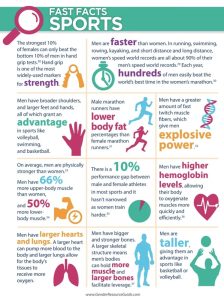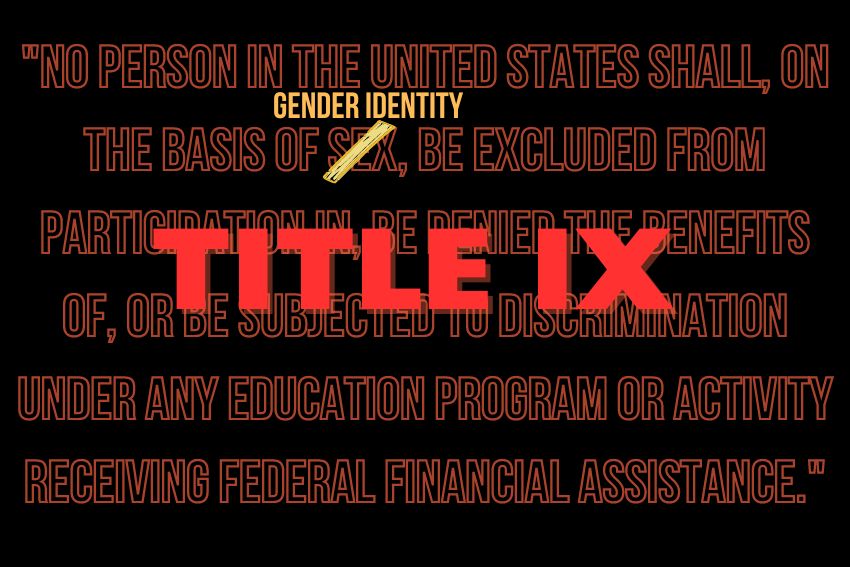“On your marks,” the starter calls. The girls participating in the 100-meter dash take their positions with their feet against the blocks and hearts pounding.
“Set.” They lift their bodies in preparation for takeoff.
The gun signals them to “Go.”
The athletes take off, propelling their bodies forward and reaching with everything in them to cross the finish line first.
These are the top young women competitors who run the 100-meter race, but today one athlete surges ahead. The crowd follows this particular athlete who climbed the rankings seemingly overnight. The difference is this athlete competed last season in the men’s division.
This year he is a she and competes in the 100 meters protected by the new clause added to Title IX signed by President Biden.
What is Title IX?
Title IX was first signed into action on June 23, 1972, as a clause under the Federal Education Amendment, stating that “no person in the United States shall, on the basis of sex be excluded from participation in, be denied the benefits of, or be subjected to discrimination under any education program or activity receiving federal financial assistance.”
Under Title IX, women in educational institutes given federal funding were being protected from sexual harassment, and given equal contingencies in core STEM classes as well as equal opportunities in athletics.
Although it was met with a fair amount of resistance, the passing of this clause was one exponential step in a positive direction for the women’s rights movement. Merely 40 years before the passing of the bill, it was an atrocity to suggest that women had the right to university, much less an outlet for athletic activities.
Five years before the first establishment of Title IX, Kathrine Switzer became a pioneer for women’s athletics. Switzer became the first female to run and complete the Boston Marathon with an official runner number in 1967. Switzer had to enroll under her last name and first initial just to get a number. On mile four, the race director screamed at her for participating. Yet, the strides she took to the finish line that day would mark the start of a social revolution.
With Switzer completing the Boston Marathon at 20 years old, she was not much older than high school girls who were also being denied athletic positions. In 1971, 93% of high school varsity athletes were male, leaving a minuscule 7% to female athletes. That number has since jumped to over 43% as of 2022.
These statistics did not improve overnight, rather change is gradual and takes time. Title IX was written with good intentions and ideals, yet the public were unaware of where it applied. After its initial introduction in 1972, people who did not agree with what Title IX put up a seven-year fight in an attempt to curtail the clause as a whole. These attempts were put to rest when the Department of Health, Education, and Welfare (HEW) took action.
In 1979, the HEW made an official statement regarding Title IX that stated it was an obligation for all government-funded education institutes to offer equal opportunity to males and females in athletic programs. The newly-assembled Department of Education upheld this.
How Title IX changed over time
Twenty-five years after the passing of Title IX, President Bill Clinton took it upon himself to emphasize the enforcement of the federal law. He pushed for a directive requiring all of his agencies to create a plan of enforcement to ensure that there was upholding of the change. Locally, universities like California State University, Fresno had to drop their ranked men’s soccer and wrestling teams in order to have funding for other women’s sports due to the unequal ratio.
Not long after, Barack Obama took office in 2007 and took an interest in Title IX as well. The Obama Administration chose to expand the clause to include affirmation of gender and gender identity under Title IX.
When the Trump Administration took charge in 2016, they decreed that each state/local school district could make its own decision about sex-separated facilities, as well as other implications of transgender athletes’ inclusion in the system.
As the 50th anniversary of the establishment of Title IX approached, Joe Biden took office and news broke of his plan to add to the clause. The Biden Administration stated plans to drastically change Title IX to “redefine the sex-discrimination to include disparate treatment on the basis of gender identity,” This addition was to hit ratification in June of 2023, but that came and went and it was pushed to October of the same year. The fall season passed, and it was not until March 2024 that the changes became official. They are set to take effect in August of 2024.
President Biden’s change has since ignited the controversy of transgender athletes in collegiate-level sports. This new claim brings up the issue that in order to “not show disparate behavior” and still give “equal opportunities in athletics,” we must affirm the preferred gender of the athlete and comply with them participating in the league they identify as. This is all despite the advantages they may have due to their original gender physique and the safety it may diminish.
The new changes made to Title IX by President Biden are far different from before. This infographic shows the contrasts:
The Biden administration has unveiled its final plan for Title IX, the regulations that require colleges to ensure that sex-based discrimination doesn’t prevent students from accessing their education. Here’s what’s changing. https://t.co/nAg2qIcY3I pic.twitter.com/vJ8S9cvMg6
— The Chronicle of Higher Education (@chronicle) April 20, 2024
The biology behind transgender athletes
After gathering information from a science educator, I have compiled the following scientifically supported information on the difference between male and female biology that would affect athletic performance. (It is important to note that these are on average)
MALES
- Biological males (X, Y) possess the Y chromosome which determines maleness including the production of testosterone and production of male reproductive organs in the uterus
- The presence of testosterone in the developing male will increase bone mass, larger and stronger lean muscle mass, a more efficient heart and larger lung capacity
FEMALES
- Biological females (X, X) only possess the X chromosome, which is responsible for the female genitals, production of estrogen, and the menstrual cycle later on in life
- Characteristics that come with females from estrogen include: the development of breasts, regulates the menstrual cycle, weight gain and widening around the waist and hips

When it comes to transgender athletes, specifically a biological male transitioning and identifying as a woman, there are several steps. Even if a biological male is on testosterone blockers, they are still able to maintain their muscle mass, their hearts have already been enlarged as they have grown up, and ultimately some changes can not be reversed.
On the flip side, unnaturally injecting estrogen will not take away a male’s genetically determined maleness. There are cases where the person will undergo surgery to remove their male genitalia, however, a biological female produces egg cells, and a biological male without his testicles does not. These two steps are taken to mimic the characteristics of a biological female, but at the end of the day, a mimicked female is not a female.
This is the most simple of explanations when it comes to the biological understanding of the difference between males and females, and how it would affect athletic performance. Numerous detailed reports by experts have been conducted that further explain these dilemmas.
With characteristics like increased bone mass, larger and stronger lean muscle mass, a more efficient heart, and larger lung capacity male athletic performance will be substantially superior in aspects that have to do with the game. Logically having a biological male serving and hitting a 50-60 mph volleyball compared to a female athlete hitting it at 35-40 mph is far different. The reaction time has to be far greater and holds higher stakes if not received correctly. Just over a year ago, the danger of transgender athletes cross-competing was seen on full display. A North Carolina high school female athlete was knocked out and concussed after facing the wrath of a spike from a transgender athlete. Payton McNabb has vocalized her story.
As a young female athlete and journalist, I took notice of this societal dilemma our country is now facing. As a defensive volleyball player myself, I especially sympathized with the injured female athlete from North Carolina. It is already harder to receive talented biological female spikes, much less a biological male. Not to mention the factors including the change in net height are just under an eight-inch difference. Combine that with their natural vertical jump and an easy hit in boy’s volleyball can be deadly in girls.

It is a given that we want to include all young people in athletic activities as it is proven to be a most beneficial outlet, yet there is a valid reason why sporting leagues are split by gender as young people begin to age. The first, and by far most important reason for gender division in sports that I see is safety. The biological facts testify to the fact that male anatomy will generally have a significant advantage over female anatomy for physical activity. But when we assess situations like the one seen in North Carolina it brings up the question no one wishes to address: When do we draw the line between the validation of the few next to the safety of the majority?
The second reason is the moral line we draw. When women have fought so hard for the opportunities they are given, how can you just strip that away? By giving these men a position in women’s sports, the casualty will always be the opportunities of a woman. Instead of making a safe space for those people, they have taken away a safe space for women.
On a collegiate level, we have witnessed this with Riley Gains and Lia Thomas. Lia Thomas, formally William Thomas, was a transgender woman competing in the 2022 National Championship for collegiate women’s swimming. Gaines and Thomas tied for fifth place in the NCAA Nationals 200 freestyle. After the meet, the official brushed off Gaines and was adamant that the trophy went to Thomas for publicity reasons. Not only was her earned position compromised but all of the biological female athlete’s right to privacy was violated when without warning they were forced to occupy the same locker room. This situation was attempted to be hushed, but Riley Gaines has vocalized the maltreatment of the biological women.
To learn more about Gaines and her fight for protection listen to her first-hand account of the situation.
Biological female athlete positions are consistently being taken away, and if they do not comply then they are labeled as “bigots” and “homophobic.” By letting these men (posing as women) compete against us and win time after time, my spot in sports is again compromised. Does that not carry strong misogynistic ideals that transgender men are ultimately in higher regard than me, a biological woman? This new addition to Title IX disregards the millions of women who fought for the right to athletic opportunity.
What is the point of Title IX if you are going to deny biological women their rights anyway? This is no longer a fight for “equal opportunities and representation for women” when women may now be in danger and have even less opportunities.
For more from The Feather read 2024 Election: Heated Rematch or FCS Town Hall offers school updates.











julia • Jun 23, 2024 at 12:35 am
sad
becide5633 • Jun 23, 2024 at 12:34 am
ncie article